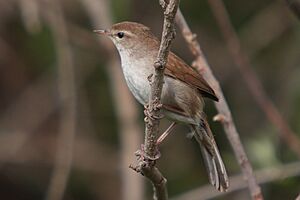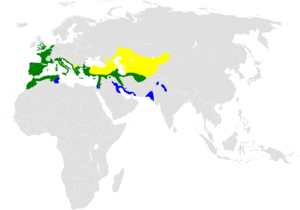Cetti's warbler facts for kids
Quick facts for kids Cetti's warbler |
|
|---|---|
 |
|
| by the Kalloni east river, Lesvos, Greece. | |
| Conservation status | |
| Scientific classification | |
| Genus: |
Cettia
|
| Species: |
cetti
|
 |
|
| Distribution of Cetti's warbler Breeding resident Breeding summer visitor Non-breeding winter | |
The Cetti's warbler (Cettia cetti) is a small, brown bird. It lives in southern and central Europe, northwest Africa, and parts of Asia. This includes places like Afghanistan and northwest Pakistan. Both male and female Cetti's warblers look very similar.
This bird gets its name from an Italian zoologist named Francesco Cetti. He lived in the 1700s. Cetti's warblers are quite hard to spot. They tend to hide in thick bushes and plants.
Contents
About the Cetti's Warbler
What Does a Cetti's Warbler Look Like?
Cetti's warblers are about 13 to 14 centimeters long. That's about the size of your hand! Male warblers weigh around 15 grams, while females are a bit lighter at 12 grams.
They have a round head with a light grey stripe above their eyes. Their eyes are black and easy to see. Their wings are short and rounded. The top part of their body is a rich, reddish-brown color. Their throat and chest are a pale grey. Their tail is longer and wider than many other warblers.
Male and female Cetti's warblers have similar feathers. However, males are usually bigger. They can be 26% to 32% heavier than females. Their wings are also longer. Young Cetti's warblers look like adults. But they have fresh feathers and two dark spots on their tongue.
Cetti's warblers are special among small birds. Most small birds have twelve tail feathers. But Cetti's warblers only have ten!
How Do Cetti's Warblers Sing?
Cetti's warblers are known for their loud and clear songs. They sing in short, strong bursts. Their song is very unique. This helps them find other Cetti's warblers. It also helps them avoid trying to mate with other bird species.
Where Cetti's Warblers Live
Cetti's warblers usually live in wet areas. You can find them near ponds, lakes, marshes, and rivers. They mostly eat insects.
The number of Cetti's warblers has grown a lot in Europe since 1990. Today, there are between 600,000 and 1,600,000 breeding pairs in Europe. Their numbers are stable or increasing in countries like Italy and Turkey. The only place where their numbers went down a little was Greece. But overall, Cetti's warblers are doing well.
Cetti's warblers were first seen in the United Kingdom in 1961. A very cold winter in 1984-1986 caused their numbers to drop. But they quickly recovered. Their population continues to grow there. By 2016, there were over 3,400 male warblers in England and Wales. They even started breeding in Scotland in 2023. The first Cetti's warbler was seen in Ireland in 2013. They started breeding there in 2022.
Cetti's Warbler Behavior
How Cetti's Warblers Breed
During the summer, male Cetti's warblers spend time finding their own space. This space is called a territory. While they are busy doing this, they don't spend much time with their eggs or young. After setting up their territory, males often attract more than one female. Their loud song is very important for this.
In Europe, Cetti's warblers usually lay eggs from mid to late June. They build their nest in thick, dense plants. The nest is usually about 30 to 45 centimeters off the ground.
The nest looks like a messy cup. It is made from leaves and stems. The inside is lined with soft things like feathers and hair. Only the female builds the nest. She lays 4 to 5 eggs, one each morning. The eggs are a chestnut red color. They are about 18 millimeters long and 14 millimeters wide.
The female sits on the eggs to keep them warm. This is called incubation. She starts when all the eggs are laid. The eggs hatch after 16 to 17 days. The female mostly feeds and cares for the young birds. The young birds leave the nest after 14 to 16 days. But their parents continue to feed them for at least 15 more days. The young birds can take care of themselves after about 30 days.
In Europe, Cetti's warblers usually have two groups of babies each year. They start breeding when they are one year old.
What Cetti's Warblers Eat
Cetti's warblers eat arthropods. These are small creatures like insects and their larvae. They prefer tiny insects. This is because tiny insects are easier for them to digest quickly.



